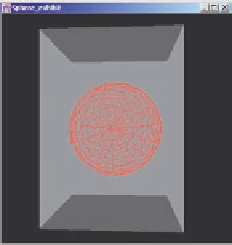Java Reference
In-Depth Information
The transparency value (tval) specifies the object's opacity. 0.0f is for fully opaque and
1.0f for fully transparent. A better appreciation can be obtained from the code segment
and result in Figure 17.
The results of using SCREEN_DOOR and BLENDED mode are given in Figure 18. As
can be seen, the use of SCREEN_DOOR gives rise to a result that is rather unpleasant as
30% of the pixels are fully transparent and 70% of the pixels are fully opaque. Essentially,
SCREEN_DOOR is faster than BLENDED at the expense of quality.
Figure 19 shows the results of having higher tval value so as to improve the transpar-
ency effect.
Figure 18. Results from Sphere_exhibit.java with tval equal to 0.3f and tmode given by
SCREEN_DOOR (left) and BLENDED (right)
// Constructs a new WakeupOnCollisionMovement criterion.
WakeupOnCollisionMovement(Node armingNode)
// Constructs a new WakeupOnCollisionMovement criterion.
WakeupOnCollisionMovement(Node armingNode, int speedHint)
// Constructs a new WakeupOnCollisionMovement criterion, where speedHint may be
// USE_BOUNDS - use geometric bounds as an approximation in computing collisions.
// USE_GEOMETRY - use geometry in computing collisions.
WakeupOnCollisionMovement(SceneGraphPath armingPath)
// Constructs a new WakeupOnCollisionMovement criterion.
WakeupOnCollisionMovement(SceneGraphPath armingPath, int speedHint)
// Constructs a new WakeupOnCollisionMovement criterion, where speedHint may be
// USE_BOUNDS or USE_GEOMETRY.
Figure 19. Results from Sphere_exhibit.java with tval/ tmode given by 0.7f/NICEST (left),
0.85f/SCREEN_DOOR (middle), and 0.7f/BLENDED, CREEN_DOOR (right)





Search WWH ::

Custom Search